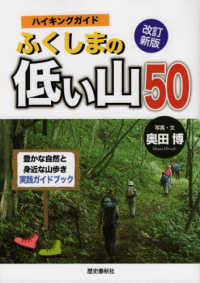- ホーム
- > 洋書
- > 英文書
- > Architecture
Full Description
Zoning is the tool that everyone loves to hate. It may also
be the most important and least understood process affecting how
US communities shape the lives of their residents. While almost every community comprehensive plan calls for more affordable,
equitable, and sustainable development, zoning is often blamed for preventing that from happening. As US communities face
an unprecedented housing affordability crisis, a long history of excluding the poor and disadvantaged
from key opportunities, and a continuing climate disaster, zoning needs to change - a lot.
In An Even Better Way to Zone, planning expert Donald L. Elliott explains
how outdated assumptions about development and
unnecessary barriers in our current zoning regulations have
contributed to development patterns that are not sustainable,
affordable, or
equitable to historically disadvantaged populations. It identifies what types of changes to zoning rules, procedures, and
maps could improve outcomes in
each of those areas. Importantly, it also helps the
reader think through what to do when
zoning changes that would improve outcomes for one
of those challenges would undermine success in the others.
An Even Better Way to Zone also reorients the
zoning discussion towards redevelopment and
reuse rather than implicitly focusing on raw land development,
because already developed areas represent the vast majority of the built environment where meaningful changes will need to be made.
Instead
of giving lip service to the importance of infill and reuse, zoning needs to actively remove the barriers that
prevent innovative, equitable, and sustainable redevelopment.
With engaging,
easy-to-understand prose, Elliott briefly explains the challenges of today's zoning and then
breaks down how this key legal
tool can be
used to reinvent our communities as places where housing is more affordable, everyone is treated fairly, and
we do far less
damage to
the environment. From fixing zoning rules and incentives to fixing the
procedures used to draft, implement,
and change zoning, Elliott provides practical, sage advice on adapting zoning to address today's most critical issues.








